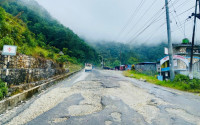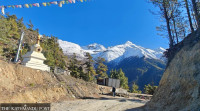Gandaki Province
Foreign hunters at Dhorpatan in quest for Naur and Jharal
One has to pay a total of Rs 375,000 to hunt a Naur in the hunting reserve.
Ghanshyam Khadka
Game hunting enthusiasts from various countries have set off for Dhorpatan Hunting Reserve, the only hunting reserve of the country, after receiving permits from the authorities.
“Seven hunters from four tourist agencies have received permits to hunt seven Himalayan blue sheep [Naur] and five Himalayan tahrs [Jharal] in the first hunting season of the year [fiscal year],” said Birendra Prasad Kandel, the chief conservation officer at the reserve. According to him, the hunters having permits will hunt the animals in the designated blocks from October 2 to December 11.
The park said that a hunting expedition including two hunters headed towards their designated block while others were all set to arrive at the reserve. The first hunting season closes in December. And the second season runs from mid-February to mid-April.
The Department of National Park and Wildlife Conservation has issued permits to hunt seven Himalayan blue sheep and five Himalayan tahrs through competitive bids. Himalaya Safari, Himalayan Wildlife, Tax and Trail and Travel Expedition have received ‘hunting booking license’ for seven hunters.
According to the reserve, the tourist agencies had bid between Rs 180,000 and Rs 195,000 to hunt each Himalayan blue sheep and Rs 80,000 to Rs 100,000 to kill each Himalayan tahr. The hunter should pay an additional amount for hunting license, block reservation and the hunting duration. The reserve office says one has to pay a total of Rs 375,000 to hunt a Himalayan blue sheep.
The Dhorpatan Hunting Reserve sprawls over 1,325 square kilometers in the Dhaulagiri Himal range of Rukum (East), Myagdi and Baglung districts. It was established in 1983 and was gazetted four years later. The reserve is divided into six blocks for hunting purposes. Approximately one-thirds of the reserve area is flat grass land, locally known as Patan, one-thirds comprises forests and hills whereas the remaining one-thirds is buffer zone.
The reserve is home to 32 species of mammals and 130 bird species. According to the reserve office, there are around 852 Himalayan blue sheep and 200 Himalayan tahrs in the reserve forests. Snow leopard, Himalayan black bear, barking deer, spotted deer, red panda, wild boar, Himalayan goral among other wildlife are also found in the reserve but their hunting is prohibited.
According to Kandel, two game hunters from Mexico, two from Ukraine, two from France and one from Russia have received permits to hunt Himalayan blue sheep and Himalayan tahrs this year. “Two Mexican hunters have permission to hunt at Dogadi and Seng blocks in Rukum (East) while the Ukrainians hunt at Gustung block of Baglung. Two French nationals have received permission to hunt at Seng and Phagune blocks of Rukum (East) while the Russian hunts in Sundaha block of Baglung district,” Kandel informed.
Himalayan blue sheep is the major attraction for the hunters.
The hunters with permits can enter their hunting blocks only after receiving permission from the reserve office to enter the forests along with a liaison officer. “The hunters are not allowed to kill baby and female animals,” said Kandel.




 16.12°C Kathmandu
16.12°C Kathmandu.jpg)








%20(1).jpg&w=300&height=200)

